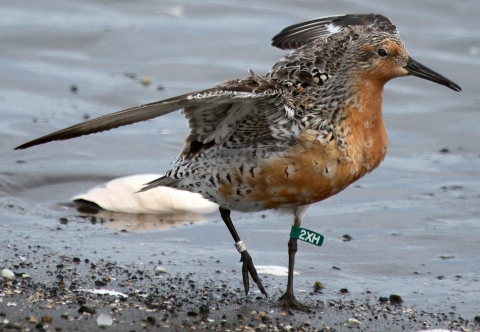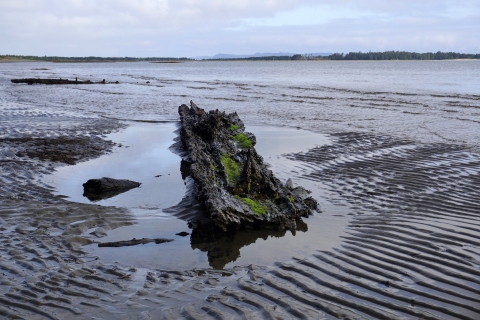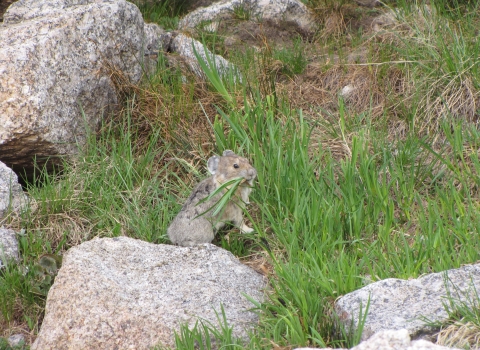“It’s such a human thing to do, isn’t it?”
Jesse Conklin, a bird ecologist and population geneticist, smiled wryly. We were talking about studying birds, and the totally weird things humans do so that we can better understand the totally routine things birds do. More specifically, we were talking about how we talk about bird species — how we go through the human exercise of dividing birds into species and subspecies.
“It’s a bit arbitrary, to be honest,” Conklin responded. “If you look at different taxa, like plants, people make those decisions differently. Or people who study slugs or crabs do it differently. There's no universal acceptance of what a subspecies is and what the rules are and how different they should be because there is no one way that species act.”
It’s a totally human thing to want to know, to sort, to categorize, to acquire knowledge and then to put it to use. Part of the work of the U.S. Fish and Wildlife Service (Service) is to do just that: To learn as much as we can about animals and their habitats and leverage that knowledge for conservation. To do that, we need words. We need descriptors — as accurate as possible — to help us all make sure we’re talking about the same thing.
You know that bird over there, the one with the long, tapered black beak, red-orange belly and gray, black, and white feathers? It lives at the beach and flies crazy-long distances? That’s a red knot.
That name, red knot — that's the common name for a bird species officially called Calidris canutus. In the Pacific Northwest, the red knot sub-species is roselaari. Calidris canutus roselaari is a set of words that scientists came up with to describe a cool bird that lives near beaches and estuaries and makes an all-too-brief appearance in the Pacific Northwest in the spring as it flies from Mexico to Alaska. Its cousin, the Calidris canutus rufa, is a subspecies of red knot that lives in the Midwest and East Coast of the U.S. and is listed as threatened under the Endangered Species Act (the roselaari is not listed). There’s a process for coming up with those words, a weird, messy human process from which we can learn as much about ourselves as we can about the birds we’re studying. This is all a bit meta, but hang with me. Maybe we'll get somewhere.
A Startling Genetic Discovery
Washington Department of Fish and Wildlife Natural Resource Scientist Joe Buchanan started his career studying northern spotted owls, or Strix occidentalis caurina if you’re into Latin. In 2006, he branched out (puns are words too!) and started researching red knots. Buchanan realized that we don’t know that much about red knot migratory patterns along the Pacific Flyway. We know that they make some pit stops in the state of Washington along their route, especially at Grays Harbor and Willapa Bay. But how long do they stay? What do they eat? How many are there? And do the birds do the same things year after year?
“Joe deserves so much credit for how much we've learned about red knots in the Pacific Northwest,” Service Wildlife Biologist Vanessa Loverti said. “Without Joe’s interests and contributions, we would know very little about the importance of these sites. He really pulled us together and led the way.”
After years of doing surveys on his own time, in 2009 Buchanan and other collaborators received funding from the Service to start officially researching the birds’ habitat and behavior. Buchanan liked to go out on an airboat during low tide on the wide, expansive mudflats in Willapa Bay and Grays Harbor where the red knots like to rest and eat.
“We’d go out in the boat, and the operator would just kill the motor so we could drift in close and count birds,” Buchanan said. “I quickly realized that the airboat would be a game changer because it would take us to places that we couldn't reach from shore, and it could skim across the mud flats in places where it wouldn't be practical for us to walk. You can’t walk out on some of those goopy mud flats. In some places it's actually treacherous.”
Buchanan, Loverti and other researchers started gathering every year at Grays Harbor and Willapa Bay to tag and track red knots. After catching a bird, the researchers placed flags with three-letter codes around one of their legs for future tracking. Then they took blood samples for genetics and health testing, weighed the birds to assess their condition, measured bill and wing length to determine sex, and place satellite tags on some of the birds to track their flight patterns.
After a few years, they made a startling discovery with Conklin’s help: analyses of the birds’ genetics showed that there isn’t just one type of Calidris canutus roselaari; there could be two. One group of red knots that stops at Grays Harbor likes to head to Wrangel Island off the northern coast of Russia to breed. The other ends their migration in Alaska. With not much known about the red knot’s overall population size—and by some estimates, a declining population size—the possibility of two genetically distinct groups raises exciting new research and management possibilities.
“We realized that instead of having one group of red knots that’s migrating through western Washington every spring and then they just happened to go to different breeding grounds, we actually have two groups,” Buchanan said. “And the fact that they are genetically distinct kind of implied that not only do they have different places where they breed, but maybe there are other things about those two populations that would be important for us to know for conservation and management.”
Population Genetics: What do YOU Put in Minestrone Soup?
Population genetics refers to the genomes of organisms across populations. It’s a study of relative differences between many birds as opposed to functional differences between individual birds. Conklin, as a population geneticist, doesn’t study the genetics that make up a bird’s wing and compare it to the genetics that make up a different bird’s wing; he looks at the entire genome of a population of birds and tries to find patterns.
“Population genetics is just like throwing all the genetic information you have into a pool and then seeing if you can tease out relative differences,” Conklin said. “You put all this information into some very complicated software and basically tried to identify whether, for instance, two groups are operating in a manner consistent with the expectations of groups that are interbreeding or not interbreeding.”
When I think of studying population genetics, I imagined a huge pot labeled “minestrone soup” filled with thousands of smaller bowls of minestrone soup. Each bowl of soup looked a little different, but based on prior inspection was deemed to have enough “minestrone-ness” to be incorporated into the larger pot.
But here’s the hitch: There are thousands of variations of soup that might possess minestrone-ness. People can generally agree that minestrone soup has a tomato-based broth, vegetables, pasta, and beans. But what if someone makes the soup with rice? What if someone uses pasta but omits the beans? What if someone includes everything but adds a little ground beef? How far can you stray from the essence of minestrone-ness before it stops being minestrone soup and starts being tomato-vegetable?
But Conklin doesn’t work with soup; he works with birds. And instead of chickpeas and zucchini, he compares 15-20,000 little genome snippets at a time looking for patterns. From those patterns, we may be able to learn about the history, behavior, and population trends of the birds. In the case of Calidris canutus roselaari, we may be learning that we’re looking at not one, but two genetically distinct bird subspecies.
Based on the knowledge of this genetic difference, researchers can look at whether the populations are coming through Washington at different times, or how they’re sorting themselves out on wintering grounds. Are they mixing or staying separate? Are there any sites that are more important than others? In other words, do the genetic differences that Conklin is discovering translate into management practices?
“If there were two subspecies, and I could tell them genetically apart, but they all went to exactly the same places in exactly the same proportions, then how could you possibly manage for them differently?” Conklin asked.
In other words, scoping out genetic differences is only one piece of the subspecies puzzle. If from a management perspective we can treat the birds as one group, then naming a separate subspecies is less important. However, if the birds are behaving in a way that suggests we need to manage them differently, then declaring a separate species could be vital.
“Estimates from 2010 show that there are about 21,000 [Pacific Flyway red knots],” Buchanan said. “In comparison, the population of western sandpipers is in the millions. So that’s really tiny. And now we’re thinking about multiple genetically distinct populations migrating through Washington and going to either Alaska or Russia. Knowing how small these subpopulations are has really important ramifications for conservation, including which habitats are most important to protect. But it’s dependent on our ability to establish a baseline on the size of those genetically distinct population segments. That’s what they’re trying to do with this project.”
Getting Somewhere -- Together
The American Ornithological Society’s North American Classification Committee is the governing body that maintains the most up-to-date official list of bird names and species in North and Central America. The Checklist of North and Middle American Birds contains all the birds on our continent, including their names, taxa and classifications. Adding or changing a species on the list requires submitting a proposal and having that proposal pass by a two-thirds vote of the committee.
The proposal guidelines appear straightforward: a submitter needs to include a description of the classification problem, new information, a recommendation, and cited literature. If, for example, I wanted to change the name of the American robin to Lev’s robin, I would need to describe why the name American robin was problematic and why naming the bird after me would solve that problem. In the case of establishing a new subspecies, the red knot researchers would need to establish not just that there are two genetically distinct groups of red knot on the Pacific Flyway, but how the two groups differ in geography, appearance, and behavior.
“I think we need to figure out what we can about the ecology of these two groups and just how different they are,” Conklin said. “Like if they are ecologically identical except for these two breeding areas, then it's not very useful or important to name a new subspecies. But let’s say we find that most of the birds from one place in Mexico breed in Alaska, and most of the birds from another breed on Wrangel Island then you would have a case for ecologically important units that could be addressed through conservation.”
Using words to describe the beautiful, complicated labyrinth of bird species and subspecies is a formidable challenge. It’s also essential that we try, and not just because we’re human and that’s the kind of thing we do, but because, as Buchanan mentioned, it could be critical for conservation. Understanding the genetic and behavioral differences within a bird species could impact our understanding of significant habitat or threats. What we learn from red knot could also inform how we approach collecting genetic information on other species. We can build on our own knowledge.
"Everything we learn about red knots in the Pacific Flyway is going to help us understand bird behavior on a more global scale," Loverti said. "Every time we do a study like this, we get to understand a little more about bird habitat, migration patterns and genetics. We learn things that we never expected to learn. I fully expect that we'll be able to use the results of this work to further conservation of both red knots and birds in general."
In “The Art of the Commonplace: The Agrarian Essays of Wendell Berry,” the author wrote, “It is not from ourselves that we will learn to be better than we are.” We humans — a flawed, messy, complicated species — can learn from the small-but-mighty Calidris canutus roselaari. We can learn about how they fly for so far and so long and apply that scholarship to our own perambulatory adventures. We can learn from the super-chill beingness of birds and try to be more mindful and present. We can learn to listen. We can learn to observe. We can learn to be better not just from the birds, but from our own study of the birds. We’ll learn from them, and we’ll learn from ourselves, and together we can get somewhere.






